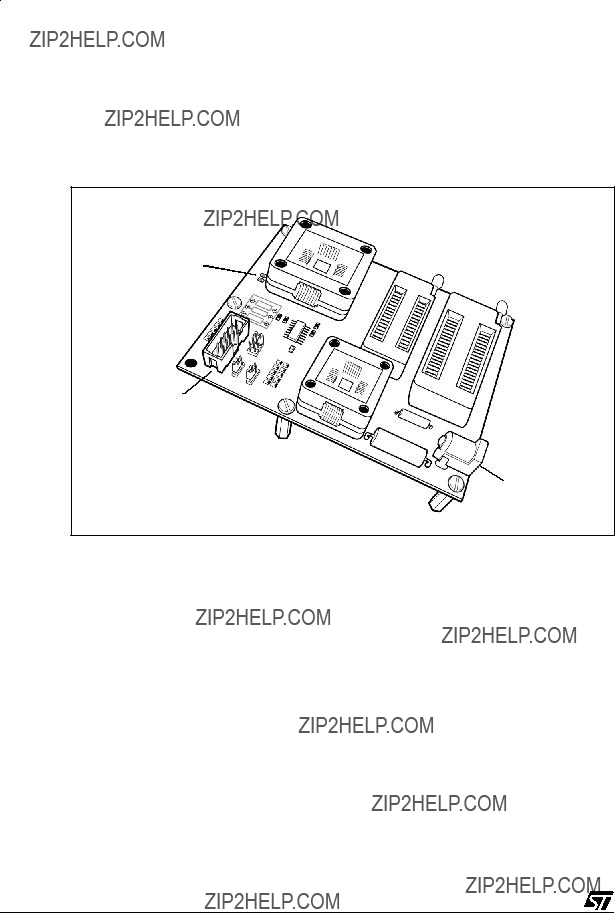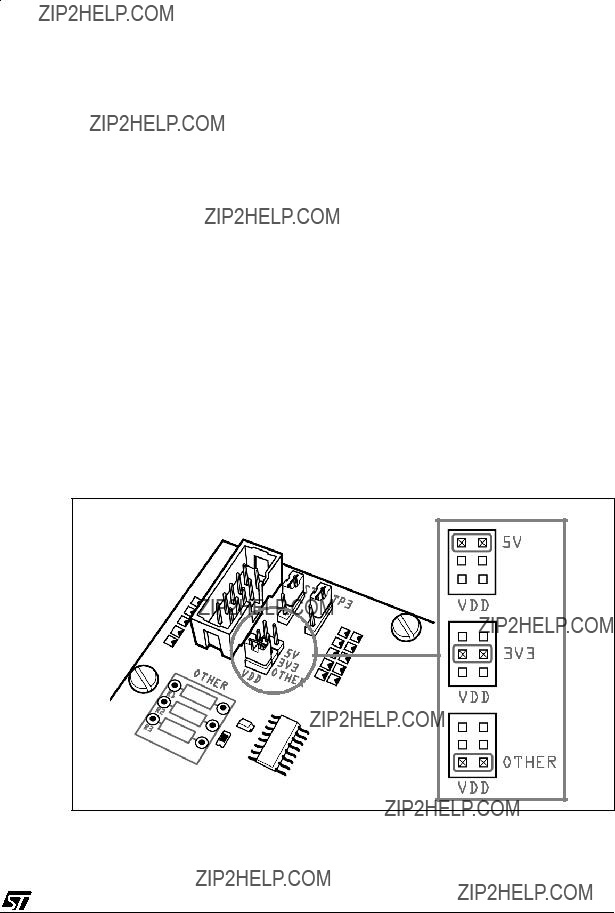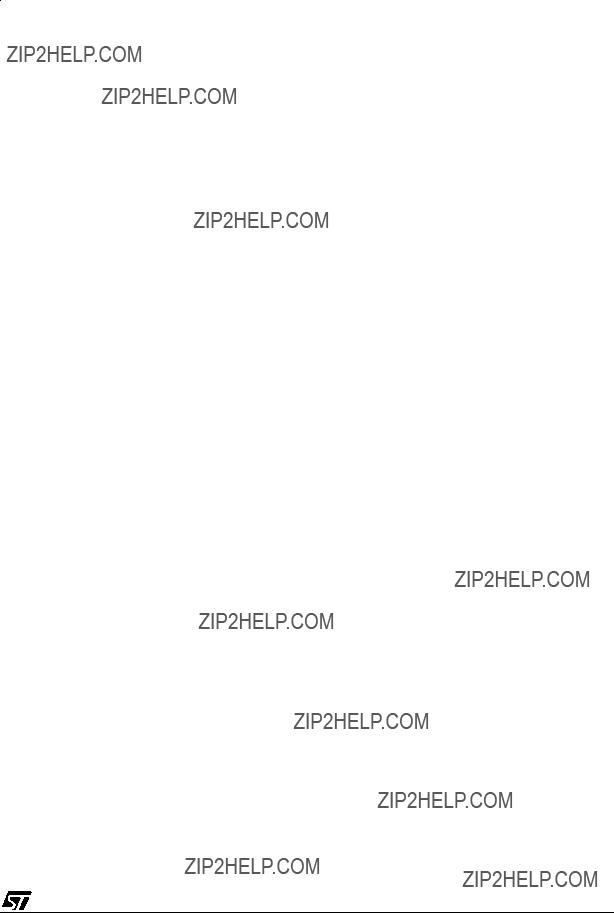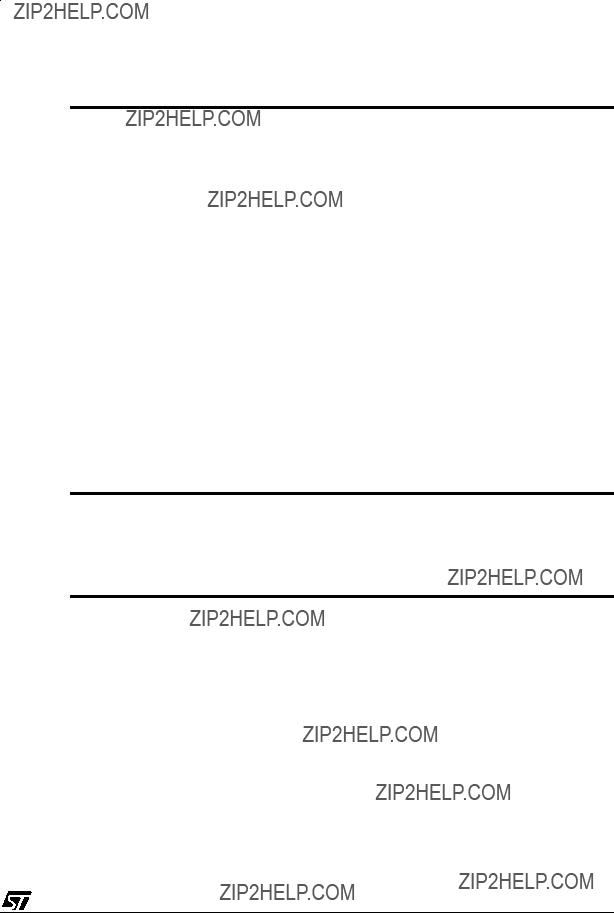
ST7SB Socket Board
User Guide
Release 1.1.1
November 2004
Ref:

ST7SB Socket Board
User Guide
Release 1.1.1
November 2004
Ref:

INSTRUCTIONS FOR
This product is conform to the 89/336/EEC Directive. It complies with the ITE EN55022 standard for EMC emissions and generic
This product is an FCC
In addition, this programming board is not contained in an outer casing; consequently, it cannot be immune against electrostatic discharges (ESD). It should therefore be handled only in static safe working areas. Please refer to Appendix A Safety Requirements on page 9 for relevant safety information
USE IN LIFE SUPPORT DEVICES OR SYSTEMS MUST BE EXPRESSLY AUTHORIZED.
STMicroelectronics PRODUCTS ARE NOT AUTHORIZED FOR USE AS CRITICAL COMPONENTS IN
LIFE SUPPORT DEVICES OR SYSTEMS WITHOUT THE EXPRESS WRITTEN APPROVAL OF STMicroelectronics. As used herein:
1. Life support devices or systems are those which (a) are intended for surgical implant into the body, or (b) support or sustain life, and whose failure to perform, when properly used in accordance with instructions for use provided with the product, can be reasonably expected to result in significant injury to the user.
2. A critical component is any component of a life support device or system whose failure to perform can reasonably be expected to cause the failure of the life support device or system, or to affect its safety or effectiveness.

1/12

1 INTRODUCTION
The ST7SB socket board complements any ST7 programming tool that is equipped for
Status LEDs 
ICC connector
(HE10 type)
 Power supply connector
Power supply connector
Figure 1: Typical ST7SBxx socket board
Your socket board uses your programming tool ???s ICC connection and connects via the ICC cable (See Section 3.2.1). The programming tool, then serves as the hardware interface with your host PC running ST7 Visual Programmer (STVP7). When using the
ST7SBxx socket boards are each designed to support the programming of a family of ST7 microcontrollers (a typical example is shown in Figure 1). For this reason, the layout of each type of socket board varies depending on the types of programming sockets required to support a microcontroller family. However, the general configuration and connection procedures explained here, remain the same for all socket boards.
2/12

Note: The ST7SBxx socket board is meant to program small numbers of microcontrollers (i.e. prototypes in the development stage). For mass production programming, we recommend using the appropriate gang, or automated programmer.
1.1About the user manuals...
This manual will help you set up your socket board. Here you will find information about:
???Configuring your socket board
???Connecting to your programming tool
???Socket board programming features
For information about the software and additional hardware intended for use with your socket board, refer to the following documents:
ST7 Visual Programmer
ST7xxxx Datasheet ??? programming information that is specific to your ST7 microcontroller
1.1.1Revision history
Table 1: STICK User Manual Revision History
3/12

2 DELIVERY CHECK LIST
Your ST7SBxx socket board (see Figure 1) is delivered with one power supply. The number and types of programming sockets will vary from one version to another depending on the available packages for the ST7 family of devices that your socket board supports. The version of your socket board is determined by the ordering code that you have specified.
All the connection cables you will need to connect to your PC are provided with the programming tool that you are using to connect to your PC.
4/12

3 CONFIGURING AND CONNECTING TO YOUR SOCKET BOARD
This chapter tells you how to set up and connect to your socket board for programming. It includes how to:
???Configure the power supply for your ST7
???Connect to the socket board
3.1Configure the power supply for your ST7
Your socket board allows you to configure the power supply (VDD) for your ST7. As standard options, you can choose between 3.3V and 5V by changing the position of the VDD jumper. In addition, you can configure other VDD supported by your ST7 by installing the appropriate resistors in series in the area labeled OTHER on your socket board.
Caution: When choosing the VDD, you must ensure that the selected voltage is supported by both your ST7 and by the programming tool that you are using to connect the socket board to your host PC. Refer to your ST7xxx Datasheet and the user manual for your programing board for more information.
Configure for 3.3V or 5V
To select 3.3V or 5V, simply set the VDD jumper to the appropriate position, as shown in Figure 2.
Figure 2: Setting the VDD jumper
5/12

Configure for other VDD
To configure your socket board to use a VDD other than 3.3V or 5V, you will have to calculate the required serial resistance and install the necessary resistors in the area labelled OTHER that is provided on your socket board. To do this:
1 Calculate the serial resistance for the voltage you want, using the formula:
RVDD.OTHER = (50 / VVDD.OTHER)
RVDD.OTHER : is the serial resistance in K??? to be installed in the OTHER area on the socket board.
VVDD.OTHER : is the desired VDD voltage.
Example to obtain a VVDD.OTHER of 4V:
RVDD.OTHER = (50 / 4) - 10 = 2.5 K???
2Install the necessary resistors in the OTHER area on the socket board. Figure 3 shows one possible solution for the example in Step 1.
3Set the VDD jumper to the OTHER position (see Figure 2).
Figure 3: Installing serial resistors
6/12

3.2Connect to the socket board
All ST7 programming tools that use a
The following sections tell you how to setup your socket board when:
???Connecting via the ICC cable (all programmers and emulators)
???Connecting via the female HE10 connector
3.2.1Connecting via the ICC cable
To connect to your socket board via ICC cable:
1Plug the ICC cable into the
2Set both POWER jumpers to the 2 position, as shown in Figure 4, inset B .
A
B
Figure 4: Power supply jumper positions
3Connect the power supply for both the socket board and the programming tool. Once connected, the green Power LED should light up and remain lit.
You are ready to program your ST7 from the STVP7 interface on your host PC.
7/12

3.2.2Connecting via the female HE10 connector
When using this connection, power for the socket board can be provided by its power supply, or by your
Note: No matter which option you choose for powering your socket board, your
To connect to the female HE10 connector on your socket board:
1Plug the male HE10 connector on the
The male HE10 connector on the
top side of your
...connects to the female connector on the bottom of your ST7SB socket board.
Figure 5: Male and female HE10 connector
2Choose a power supply configuration (i.e. both tools powered by the ST7- STICK, or each tool powered by its own power supply) and set the POWER jumpers on your socket board to the appropriate position:
-Set POWER to 1 if the socket board is supplied by the
-Set POWER to 2 if the socket board is supplied by its own power supply as shown in Figure 4, inset B.
3Plug in the appropriate power supply, or power supplies. Once connected, the green Power LED should light up and remain lit.
You are ready to program your ST7 from the STVP7 interface on your host PC.
8/12

APPENDIX A SAFETY REQUIREMENTS
???Any tester, equipment, or tool used at any production step, or for any manipulation of semiconductor devices, have its shield connected to ground.
???The product must be placed on a conductive table top, made of steel or clean aluminum, or covered by an antistatic surface (superficial resistivity equal to or
higher than 0.5 M???/cm2), grounded through a ground cable (conductive cable from protected equipment to ground isolated with a 1 M??? resistor placed in
series). All manipulation of finished goods must be done at such a grounded worktable.
??? The worktable free of all
???An antistatic floor covering grounded through a conductive ground cable (with serial resistor between 0.9 and 1.5 M???) should be used.
???It is recommended that you wear an antistatic wrist or ankle strap, connected to the antistatic floor covering or to the grounded equipment.
???If no antistatic wrist or ankle strap is worn, before each manipulation of the
???It is recommended that antistatic gloves or finger coats be worn.
???It is recommended that nylon clothing be avoided while performing any manipulation of parts.
9/12

PRODUCT SUPPORT
If you experience any problems with this product, contact the distributor or the STMicroelectronics sales office where you purchased the product. Phone numbers for major sales regions are provided in the Contact List, below.
In addition, at our Internet site www.st.com/mcu, you will find a complete listing of ST sales offices and distributors, as well as documentation, software downloads and user discussion groups to help you answer questions and stay up to date with our latest product developments.
Software updates
All our latest software and related documentation are available for download from the ST Internet site, www.st.com/mcu.
Hardware spare parts
Your development tool comes with the hardware you need to set it up, connect it to your PC and connect to your application. However, some components can be bought separately if you need additional ones. You can order extra components, such as sockets and adapters, from STMicroelectronics, from the component manufacturer or from a distributor.
To help you find what you need, a listing of accessories for ST development tools is available on the ST internet site, www.st.com/mcu.
10/12

Contact List
North America
Note: For American and Canadian customers seeking technical support the US/ Canada is split in 3 territories. According to your area, contact the appropriate sales office from the list above and ask to be transferred to an
Europe
France +33 (0)1 47 40 75 75
Germany +49 89 46 00 60
U.K. +44 162 889 0800
Asia/Pacific Region
Japan +81 3 3280 4120
Sydney +61 2 9580 3811
Taipei +88 6 2 2378 8088
11/12
Information furnished is believed to be accurate and reliable. However, STMicroelectronics assumes no responsibility for the consequences of use of such information nor for any infringement of patents or other rights of third parties which may result from its use. No license is granted by implication or otherwise under any patent or patent rights of STMicroelectronics. Specifications mentioned in this publication are subject to change without notice. This publication supersedes and replaces all information previously supplied. STMicroelectronics products are not authorized for use as critical components in life support devices or systems without the express written approval of STMicroelectronics.
The ST logo is a registered trademark of STMicroelectronics
???2004 STMicroelectronics - All Rights Reserved.
Purchase of I2C Components by STMicroelectronics conveys a license under the Philips I2C Patent. Rights to use these components in an I2C system is granted provided that the system conforms to the I2C Standard Specification as defined by Philips.
STMicroelectronics Group of Companies
Australia - Belgium - Brazil - Canada - China - Czech Republic - Finland - France - Germany - Hong Kong - India - Israel - Italy - Japan -
Malaysia - Malta - Morocco - Singapore - Spain - Sweden - Switzerland - United Kingdom - United States of America
www.st.com